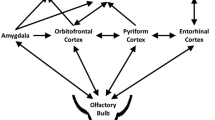Abstract
It has been suggested that the olfactory bulb, the first processing center after the sensory cells in the olfactory pathway, plays a role in olfactory adaptation, odor sensitivity enhancement by motivation and other olfactory psychophysical phenomena. In a mathematical model based on the bulbar anatomy and physiology, the inputs from the higher olfactory centers to the inhibitory cells in the bulb are shown to be able to modulate the response, and thus the sensitivity of the bulb to specific odor inputs. It follows that the bulb can decrease its sensitivity to a pre-existing and detected odor (adaptation) while remaining sensitive to new odors, or increase its sensitivity to interested searching odors. Other olfactory psychophysical phenomena such as cross-adaptation etc. are discussed as well.
Similar content being viewed by others
References
Baird B (1986) Nonlinear dynamics of pattern formation and pattern recognition in rabbit olfactory bulb. Physica 22 D:150–175
Cain WS, Engen T (1969) Olfactory adaptation and the scaling of odor intensity. In: Pfaffmann C (eds) Olfaction and taste. Rockefeller Press, New York, p 127–141
Chaput MA, Panhuber H (1982) Effects of long duration odor exposure on the unit activity of olfactory bulb cells in awake rabbits. Brain Res 250:41–52
Freeman WJ (1978) Spatial properties of an EEG event in the olfactory bulb and cortex. Electroencephalogr Clin Neurophysiol 44:586–605
Freeman WJ (1979a) Nonlinear gain mediating cortical stimulus-response relations. Biol Cybern 33:237–247
Freeman WJ (1979b) Nonlinear dynamics of paleocortex manifested in the olfactory EEG. Biol Cybern 35:21–37
Freeman WJ (1979c) EEG analysis gives model of neuronal template-matching mechanism for sensory search with olfactory bulb. Biol Cybern 35:221–234
Freeman WJ, Schneider WS (1982) Changes in spatial patterns of rabbit olfactory EEG with conditioning to odors. Psychophysiology 19:44–56
Freeman WJ, Skarda CA (1985) Spatial EEG patterns, non- linear dynamics and perception: the Neo-Sherringtonian view. Brain Res Rev 10:147–175
Getchell TV, Shepherd GM (1978) Responses of olfactory receptor cells to step pulses of odour at different concentrations in the salamender. J Physiol 282:521–540
Gray CM, Skinner JE (1988) Centrifugal regulation of neuronal activity in the olfactory bulb of the waking rabbit as revealed by reversible cryogenic blockade. Exp Brain Res 69:378–386
Lancet D (1986) Vertebrate olfactory reception. Ann Rev Neurosci 9:329–355
Li Z, Hopfield JJ (1989) Modeling the olfactory bulb and its neural oscillatory processings. Biol Cybern 61:379–392
Moncrieff RW (1967) The chemical senses. CRC Press, Boca Raton, Fla
Pryor GT, Steinmetz G, Stone H (1970) Changes in absolute detection threshold and in subjective intensity of suprathreshold stimuli during olfactory adaptation and recovery. Percept Psychophys 8:331–335
Scott JW (1986) The olfactory bulb and central pathways. Experientia 42:223–232
Shepherd GM (1979) The synaptic organization of the brain. Oxford University Press, New York
Sicard G, Holley A (1984) Receptor cell responses to odorants: similarities and differences among odorants. Brain Res 292:283–296
Skarda CA, Freeman WJ (1987) How brains make chaos in order to make sense of the world. Behav Brain Sci 10:161–195
Steinmetz G, Pryor GT, Stone H (1970) Olfactory adaptation and recovery in man as measured by two psychophysical techniques. Percept Psychophys 8:327–330
Author information
Authors and Affiliations
Rights and permissions
About this article
Cite this article
Li, Z. A model of olfactory adaptation and sensitivity enhancement in the olfactory bulb. Biol. Cybern. 62, 349–361 (1990). https://doi.org/10.1007/BF00201449
Received:
Accepted:
Issue Date:
DOI: https://doi.org/10.1007/BF00201449




